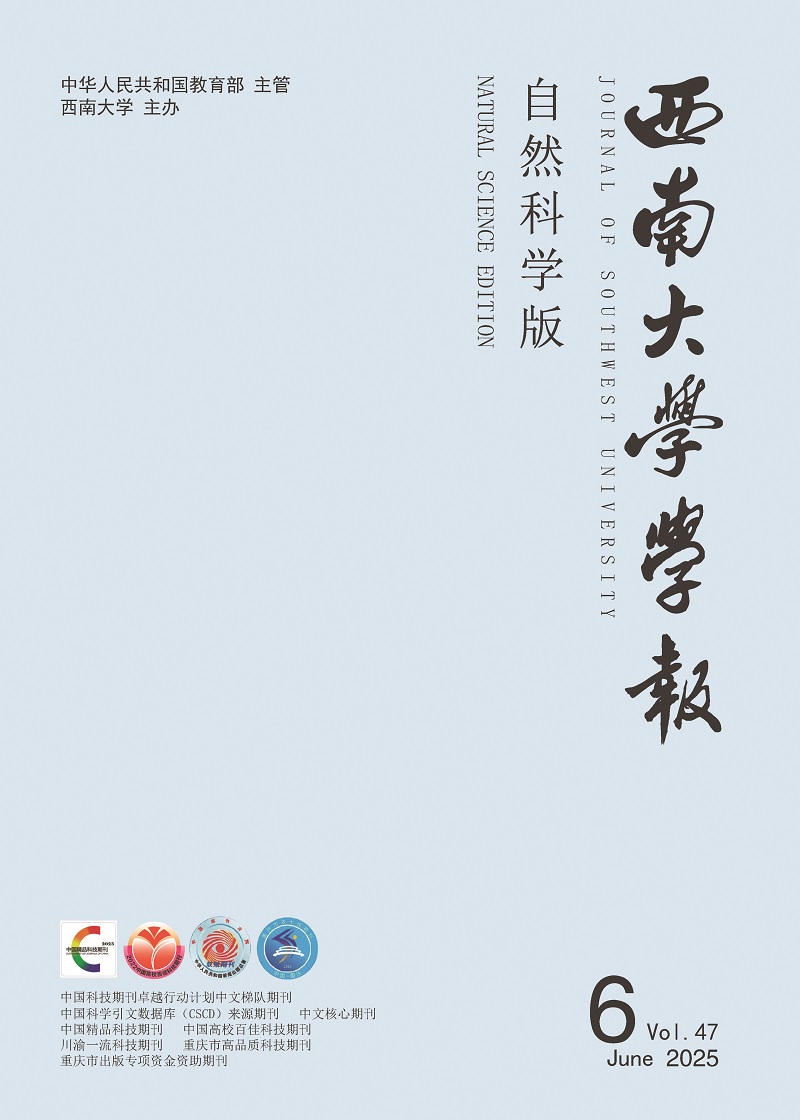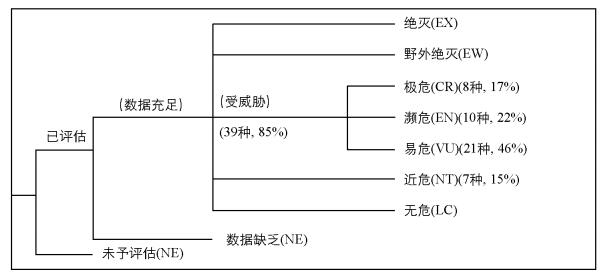-
珍稀濒危及保护物种的保护是生物多样性保护最为直接的形式,而珍稀濒危及保护物种濒危等级评估是生物多样性保护的一项基本任务,是确定保护优先项目,制订保护法规和保护物种名录、保护规划,建立自然保护区,开展科学研究和普及教育等工作的重要依据.
保护植物濒危等级的评估及名录的发布成为人们参与生物多样性保护及自然资源管理等活动的重要工具,极大地促进了生物多样性的保护.但国际级和国家级保护级别及保护名录主要针对全球和国家水平,对地方性物种的保护针对性不强.为此,生物多样性较为丰富的省(直辖市、自治区)均根据自身物种多样性情况制定了省级保护物种等级,并公布了保护物种名录.
重庆市位于长江上游三峡库区,独特的地形及气候特点孕育了丰富的植物资源.以往对植物的保护工作主要依据《国家重点保护野生植物名录(第一批)》[1]、《中国物种红色名录(第一卷·红色名录)》[2]等标准.重庆市不仅有丰富的珍稀濒危及国家重点保护植物,还有丰富的地方特有植物、模式植物、三峡库区消落带植物、重要科研和经济价值植物,如崖柏、荷叶铁线蕨、缙云黄芩、缙云卫矛Euonymus chloranthoides、疏花水柏枝Myricaria laxiflora、南川木波罗Artocarpus nanchuanensis、金佛山兰Tangtsinia nanchuanica、南川升麻等,这些植物在重庆市分布范围极为狭窄、种群数量较低,处于不同程度的受威胁状态,有的甚至濒临灭绝,由于没有被上述名录收录,这些野生珍稀濒危植物的保护工作没有得到重视. 《重庆市重点保护野生植物名录(第一批)》[3]的编制及对名录中植物受威胁状态的重新评估,有利于切实保护这些植物物种.
HTML
-
评估对象为《重庆市重点保护野生植物名录(第一批)》[3]所列的46种市级重点保护植物(表 1).重庆市重点保护野生植物是重庆市政府委托本课题组编制,于2015年2月13日发布的非国家保护植物.其中崖柏、缙云黄芩、南川木波罗、金佛山兰属地区特有种且极小种群物种;疏花水柏枝、荷叶铁线蕨为极小种群物种;野核桃Juglans cathayensis、中华猕猴桃Actinidia chinensis是重要经济植物近缘种;阔叶樟Cinnamomum platyphyllum、细叶楠Phoebe hui、紫楠Phoebe sheareri、木通马兜铃(关木通Aristolochia manshuriensis)、朱砂莲(背蛇生Aristolochia tuberose)、川黔紫薇Lagerstroemia excelsa、延龄草Trillium tschonoskii等具有潜在的重要经济价值、药用价值或观赏价值.
-
评估标准包含以下方面:种群数变化;分布区域占有面积的现状及变化;成熟个体数及变化;定量分析今后10年或3个世代内野外灭绝的机率[2].当一个分类单元的野生种群符合一个受威胁等级标准中的任何一条标准时,该分类单元即可列为该受威胁等级.
整个等级体系包括绝灭(Extinct,EX)、野外绝灭(Extinct in the Wild,EW)、极危(Critically Endangered,CR)、濒危(Endangered,EN)、易危(Vulnerable,VU)、近危(Near Threatened,NT)、无危(Least Concern,LC)、数据缺乏(Data Deficient,DD)、未予评估(Not Evaluated,NE),其中极危(CR)、濒危(EN)、易危(VU)为受威胁等级,是整个等级体系中的一部分[2],见图 1.
-
本课题组通过查阅相关文献资料,包括《中国植物红皮书(第一册)》[4]、《中国物种红色名录(第一卷·红色名录)》[2]、《重庆维管植物检索表》[5]和《四川植物志》[6]等,了解各物种的分布区及主要价值等信息;在《中国植物红皮书(第一册)》[4]、《中国物种红色名录(第一卷·红色名录)》[2]及IUCN红色名录网站(http://www.iucnredlist.org/amazing-species)查询各物种的濒危等级.到重庆市重点保护野生植物主要分布区县如南川、城口、巫溪、巫山等以及各自然保护区如缙云山国家级自然保护区、金佛山国家级自然保护区、阴条岭国家级自然保护区、大巴山国家级自然保护区等生物多样性丰富的保护区调查,访问重点保护野生植物分布地附近居民和各保护区工作人员,以了解并调查保护植物的种群分布、数量、生长状况等信息.此外,课题组拥有多年的野外调查数据,并针对性地对缙云黄芩[7-9]、荷叶铁线蕨、崖柏[10]、北碚榕[11]、缙云卫矛[12]等物种进行了长期的调查监测和研究.重庆分布的各物种成熟个体数量的评估结果见表 1.根据以上调查研究获得的数据,计算和推测各种植物种群数的变化、分布区域占有面积的现状及变化、成熟个体数及变化等信息.
-
根据计算和推测的各物种种群数的变化、分布区域占有面积的现状及变化、成熟个体数及变化等信息,参照《IUCN物种红色名录濒危等级和标准(3.1版)》[2]对重庆市重点保护野生植物濒危等级进行评估.
以缙云黄芩为例,通过对缙云黄芩的调查,发现其仅存于缙云山的9个地点,分布区面积仅约1.5km2,种群被严重分割,占有面积仅为150 m2,最小的只有0.07 m2.从生境来看,虽然目前还有少数岛屿状的适宜生境,但这些生境极易受到人类活动的影响,可以推断其部分生境面积狭小的亚种群在未来将持续衰退.因此,根据上述缙云黄芩的野外生存状况,按照IUCN红色名录标准B1ab(iv)+2ab(iv),判断缙云黄芩处于极危(CR)状态.
2.1. IUCN红色名录评估标准
2.2. 数据收集
2.3. 等级评估
-
评估显示处于极危(CR)、濒危(EN)、易危(VU)、近危(NT)的种数分别是8种、10种、21种、7种,见图 1,具体信息见表 1.
-
与《中国植物红皮书(第一册)》 [4]的内容对比,《中国植物红皮书(第一册)》[4]有30种未收录,已收录的16种变化情况见表 2.与《中国物种红色名录(第一卷·红色名录)》[2]的内容对比,《中国物种红色名录(第一卷·红色名录)》[2]有10种未予评估,等级相同的有24种,不同的有12种,不同的差异较大,见表 3.与《中国生物多样性红色名录-高等植物卷》[13]的内容对比,等级相同的有18种,不同的有28种,见表 4.
与IUCN物种红色名录濒危等级相比较,IUCN物种红色名录中有32种未予评估,濒危等级相同的有5种,不同的有9种,这9种此次评估结果的濒危等级均高于IUCN物种红色名录濒危等级,见表 5.
3.1. 评估结果
3.2. 评估结果与以往文献收录各物种濒危等级的比较
-
本次评估结果与《中国植物红皮书(第一册)》[4]的内容对比,可以看出其由于年代久远,多数未收录,已收录物种的濒危等级现在也发生了较大变化.
与《中国物种红色名录(第一卷·红色名录)》[2]的内容对比,濒危等级不同的有12种,且差异较大.崖柏由极危(CR)变为濒危(EN),可能是由于近年来对崖柏进行了较好的保护和考察;缙云黄芩由无危(LC)变为极危(CR),说明近年来对缙云黄芩的考察反映出其种群数量、占有面积及个体数少,整个物种处于极危状态.
与《中国生物多样性红色名录-高等植物卷》[13]的内容对比,多数物种濒危等级增高,说明这些物种在重庆市范围内生存形势较全国范围更严峻.
从IUCN物种红色名录濒危等级和此次评估结果相比较来看,此次在重庆市范围内评估了IUCN中未予评估的32个物种,补充了重庆市范围内重点保护野生植物的保护依据,为重庆市范围内对这些物种的保护提供指导意义.濒危等级相同的有5种,说明这些物种在重庆市范围与全国或世界范围的生存状态相似;濒危等级不同的有9种,这9个物种在重庆市范围内的成熟个体数、种群数少于IUCN物种红色名录濒危等级依据的全国范围或世界范围,说明其在重庆市以外也有分布,在重庆市范围内对其的保护为全国范围内的保护提供保障.
本文可以看出,重庆市重点保护野生植物多是重庆特有、模式植物或珍稀濒危植物,且具有一定的科研、经济等价值.重庆市重点保护野生植物没有《国家重点保护野生植物名录(第一批) 》[1]中已收录的物种,且主要分布区在重庆市,野外种群数量少,生存状况差,在重庆市范围内对这些物种着重保护尤为重要.
-
建议进一步加强对重庆市重点保护野生植物资源的调查工作.鉴于目前主要掌握的重庆市重点保护野生植物的分布地、大致个体数量、分布面积等信息,其具体种群数量、分布区域、占有面积、成熟个体数等数据多由估算得来,这些数据还需进一步地调查获得,调查后可全面掌握这些数据并进行动态监测,以便更好地对这些植物进行保护.
重庆市重点保护野生植物多数分布在各保护区,保护区工作人员应在掌握这些物种的分布区域、种群数量等相关数据的基础上明确保护责任,切实做好保护工作.
加强重点保护野生植物的引种、繁育、栽培研究.部分重点保护野生植物具有园林、食用或药用等价值,可对其进行引种、繁育、栽培研究,如已经引种繁育的有崖柏[14]、北碚榕[15-17]等.处于极危(CR)的有荷叶铁线蕨、中华双扇蕨、南川升麻、南川木波罗、北碚榕、疏花水柏枝、缙云黄芩、麻栗坡兜兰Paphiopedilum malipoense,这些是在重庆市分布范围极小或仅分布在重庆市的物种.重庆市地质地貌复杂,水热条件充沛,气候垂直差异显著,河流众多,水体环境多样化,优越的地理位置和复杂的自然条件,造就了重庆市丰富多样的生态系统类型和极高的物种多样性.而以上极危(CR)物种的分布区域极小,生境要求特殊,如不加以重视,极易被破坏,使以上物种处于绝灭的边缘.应建立重庆市重点保护野生植物种质资源库,收集保存重庆市重点保护野生植物种质资源,尤其是处于极危(CR)、濒危(EN)的物种.
提高公众对上述珍稀濒危植物的认识,加大宣传教育力度.目前,崖柏、细叶楠、紫楠等多数珍稀濒危植物的功用被夸大宣传甚至炒作,以致被大肆开采砍伐,面临严重威胁.各级部门应对其现有的利用价值进行客观地宣传,侧重宣传这些植物的种质资源价值和潜在价值,遏制夸大其功用甚至炒作的风气,同时对其受威胁状态及保护工作的重要性进行积极的宣传.







 DownLoad:
DownLoad: